2025 Edition|What is Real Life in China? Daily Habits and Current Trends Marketers Should Know
- Release date: Nov 17, 2025
- Update date: Nov 17, 2025
- 134 Views
- Usage and altitude
- Consumer Electronics
- Furniture and home furnishings
- China
- Culture/Habit
- Personal Care

Many marketers likely feel, “We want to enter the Chinese market, but we can't see the reality of local consumers' lives.” For marketing success, it's crucial to understand the values and motivations behind consumers' actions—insights that can't be gleaned from numbers and statistics alone.
This article provides a detailed look at Chinese housing, food culture, daily habits, and hygiene awareness, based on visual data from actual households in Intage's overseas consumer visual database, “Consumer Life Panorama” (commonly known as CLP).
By offering a multifaceted understanding of consumers' real daily lives, we provide insights for developing marketing strategies rooted in the local context.
目次
1. Introduction
(1) Demographics
(2) Average household size
(3) Per capita household disposable income (annual)
(4) Climate Information
2. [Housing Edition] China's Housing Environment and Values: How They Differ from Japan's
(1) Urban Housing Conditions: Surprisingly Not That Spacious? Floor Plans and Characteristics
(2) Maximizing Space Utilization
(3) But does the kitchen have nothing to do with space utilization?
(4) Is the refrigerator placed in the living room? And regarding the entranceway, the approach differs from Japan's.
(5) Just because it's a Chinese household doesn't mean only Chinese appliances are used?
3. [Daily Life Edition] Since China has different housing environments, daily life within them naturally differs as well.
(1) Drink plain hot water instead of warm tea?
(2) Chinese consumers embracing sour flavors
(3) Differences in Hygiene Awareness Between China and Japan
(4) Chinese Consumers Obsessed with Indoor Air Quality
(5) Dental Care Situation
(6) Cleaning methods specific to each space due to the use of different flooring materials
(7) Sleep Patterns Among Chinese Consumers
4. Observing from a Marketing Perspective: Business Opportunities Revealed Through Chinese Daily Life
1. Introduction
First, we introduce various “average values” concerning Chinese households, such as per capita disposable income and family composition.
When conducting market research, it's essential to grasp these fundamental indicators of Chinese lifestyles. Comparing them with typical Japanese living conditions helps you understand the differences, significantly altering how you interpret data and perceive the market.
Here, we examine specific average values related to the lives of Chinese consumers.
(1) Demographics
Compared to Japan, where aging is progressing, China as a whole tends to have a younger average age.
The proportion of people in their 20s to 50s is particularly high, with the prime working-age generation forming the core of the population. In other words, China still has a large working-age population and a significant number of young people. This social structure means that consumption and trend formation are also concentrated among this demographic.

For specific figures on the composition ratio by gender and age group, please refer to this data.
Population by Sex and Age Group (10-Year Intervals)_China https://www.global-market-surfer.com/market/detail/19
(2) Average household size
In Japan, where nuclear families and single-person households are increasing, the average household size is 2.33 people. In contrast, China's average household size is 3.38 people, showing a tendency for more residents per household than in Japan.
For 2021 and 2022 figures for 14 countries including East Asia and Southeast Asia outside of China, please see here.
Average Household Size_14 Countries https://www.global-market-surfer.com/market/detail/192/
(3) Per capita household disposable income (annual)
Japan's annual per capita household disposable income is approximately ¥3.85 million (2022), while China's is approximately ¥830,000 (2023, 39,218yuan).
A simple comparison shows Japan has about four times the disposable income of China, but this figure includes rural areas with lower income levels.
When limited to urban areas, the gap between the two countries narrows somewhat, but Japan still has higher per capita disposable income.
View data comparing disposable income across 9 countries here.
Per capita household disposable income_9 countries https://www.global-market-surfer.com/market/detail/549/
(4) Climate Information
Here, we explain climate information comparing Shanghai and Beijing with Tokyo.
▼Shanghai vs. Tokyo
Shanghai receives more precipitation than Tokyo from April to August, while it tends to receive less precipitation than Tokyo from April to May and from September to December. Regarding temperature, Tokyo has higher summer highs, but Shanghai has higher lows throughout the year and remains relatively mild even in winter.
Overall, Shanghai's climate closely resembles Tokyo's, and the seasonal transitions are familiar to Japanese people.
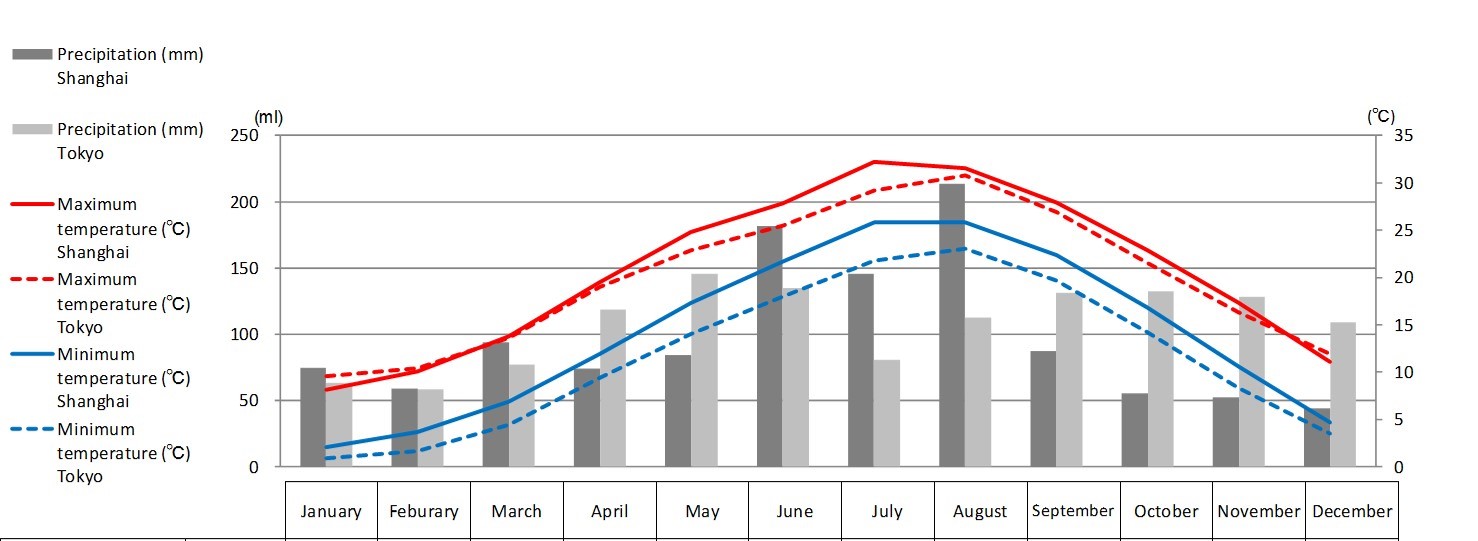
▼Beijing vs Tokyo
Beijing's temperatures tend to be colder than Tokyo's in winter, while summer temperatures are similar to or slightly higher than Tokyo's.
However, due to its continental climate, humidity is low, making it less prone to the muggy heat often experienced in Tokyo. Additionally, precipitation tends to be higher in Beijing than in Tokyo during the summer months of July and August.
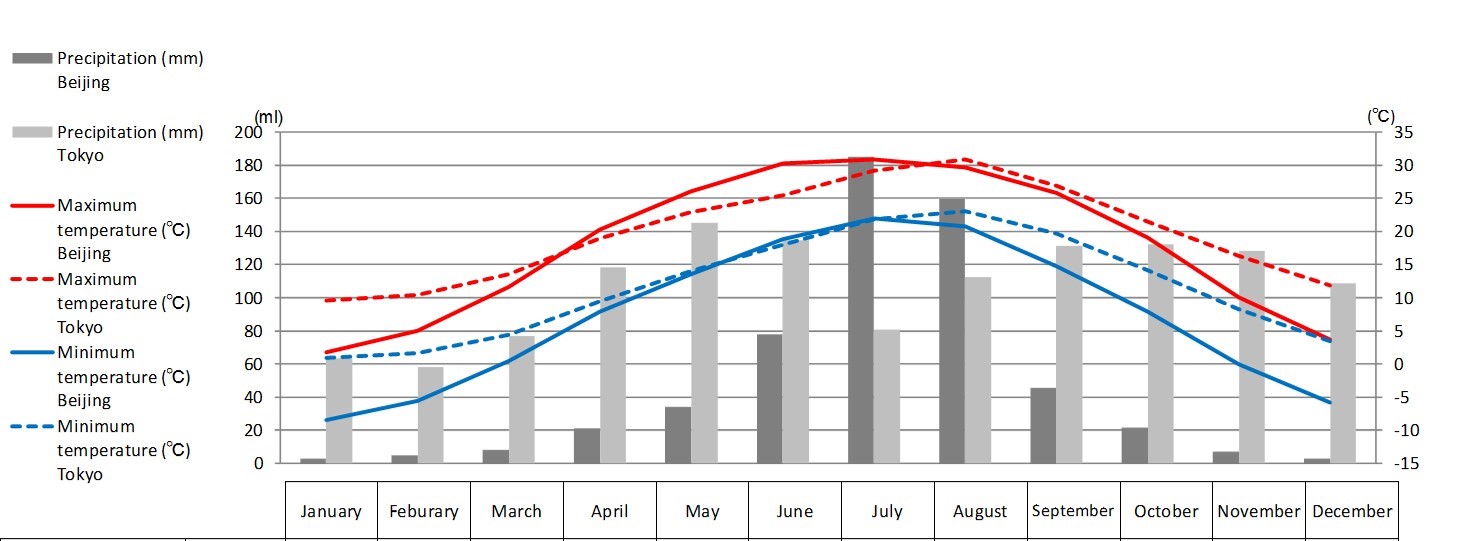
For detailed information on humidity, precipitation, and other weather conditions in Shanghai and Beijing, please check here.
2. [Housing Edition] China's Housing Environment and Values: How They Differ from Japan's
Understanding the differences in living environments and values is essential to grasping the Chinese market. Housing reflects people's lifestyles, consumption behaviors, and even social status.
Alongside economic development, China's living environments have undergone significant changes, with soaring real estate prices, urban-rural disparities, and new values centered around Generation Z all intertwining in complex ways. The mindset of “what kind of home people want to live in” directly influences “what products and services they seek.”
This chapter unravels the realities of modern Chinese living environments and explores the marketing insights that emerge from them.
(1) Urban Housing Conditions: Surprisingly Not That Spacious? Floor Plans and Characteristics
China's vast territory often leads to the perception that “China's wealthy = spacious, luxurious homes,” but the reality for many ordinary households living in first-tier cities like Shanghai, Beijing, and Shenzhen is different.
In urban areas, soaring housing prices are even more severe than in Japan, making it difficult for young people and families to secure ideal housing within limited budgets. As a result, similar to Japan's urban areas, the current reality is that per capita living space is by no means spacious.
The internal structure of homes also has distinct features. While in Japan, the bathroom, washroom, and toilet are typically separate, in China, shower rooms, sinks, and toilets are often simply partitioned by glass doors or similar dividers and combined into a single space.
Furthermore, bathing is a deeply ingrained habit in Japan, and even small homes often include a bathtub. In contrast, shower-only designs are the norm in China, and bathtubs are rarely seen outside of spacious villas or luxury hotels.
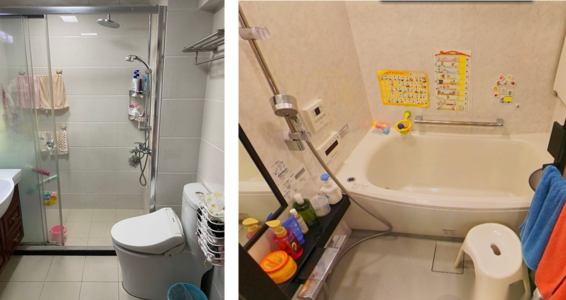
Chinese shower-only bathroom (left), Japanese bathtub-equipped bathroom (right)
(Source: Consumer Life Panorama)
As shown in the photo above on the left, in many Chinese households, the shower, sink, and toilet are all located in the same space. Consequently, it's not uncommon for families to struggle with items around the sink and toilet getting wet every time someone uses the shower.
Furthermore, while installing ventilation fans in shower rooms is standard practice in Japan, many Chinese homes still lack adequate ventilation systems.
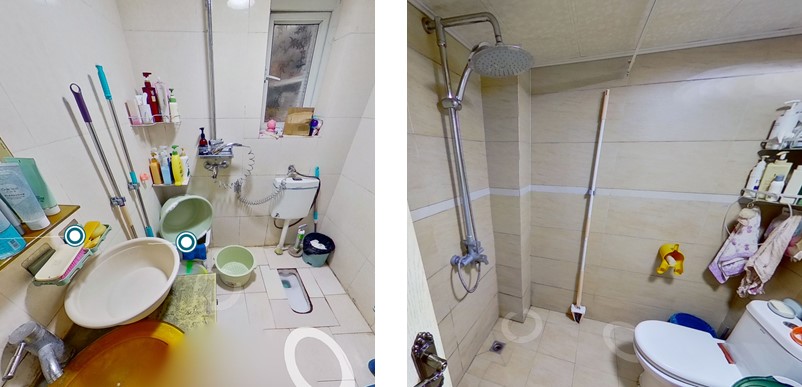
Chengdu bathrooms with shower, sink, and toilet in the same space (Left: CN_82, Right: CN_84)
(Source: Consumer Life Panorama)
There are also differences in attitudes toward bathing. In China, the primary purpose is “cleaning the body,” while in Japan, in addition to maintaining cleanliness, “soaking in the bath to relax” is also highly valued.
In China, many bathroom designs combine the bathing area and toilet into the same space, creating a gap in values compared to Japanese people. This article explains in detail the unique water-related circumstances found locally, such as why the bath and toilet are together and how cleaning is handled.
(2) Maximizing Space Utilization
Within the constraints of limited space, Chinese residents make effective use of every available area. A prime example is the balcony.
In Japan, balconies are considered common areas, designed to be open and not counted as living space. Modifications are also restricted. In China, however, balconies are treated as private property and included in the living area. Therefore, how they are used is entirely up to the residents. In many homes, the balcony itself is designed as an indoor space. As a result, it is common for balconies to serve multiple purposes, such as storage, laundry, or as a workspace.

Typical balcony of an apartment building in Japan (left) and China (right)
(Source:Consumer database (Consumer Life Panorama))
In China, many households remove doors or walls separating balconies adjoining bedrooms, integrating them into a single living space. It's also common to install large wardrobes on the balcony side to expand storage.
Furthermore, when the balcony faces the living/dining area, integrating the space creates a more spacious and relaxing environment. It is also frequently utilized as a multifunctional area, often accommodating plants or a washing machine.
For indoor balconies, the significant advantage is the ability to dry laundry in good sunlight without being affected by the weather.

Balcony with integrated bedroom and washing machine
(Source:Consumer database (Consumer Life Panorama))
Air conditioner units are often installed on balconies in Japan, but what about in China? For Chinese-style balcony utilization techniques, check out this article.
(3) But does the kitchen have nothing to do with space utilization?
Chinese consumers are adept at cleverly utilizing limited space, but when it comes to kitchens, the situation is slightly different.
While open-concept kitchens are becoming mainstream in Japan, in China, many households prioritize a separate kitchen, even at the cost of space.
This preference stems from the unique cooking styles inherent to Chinese cuisine. Frequent stir-frying and deep-frying generate oil, smoke, steam, and odors, making the kitchen area prone to messes.
For these reasons, a “separate kitchen space” that doesn't affect other living areas is highly valued.
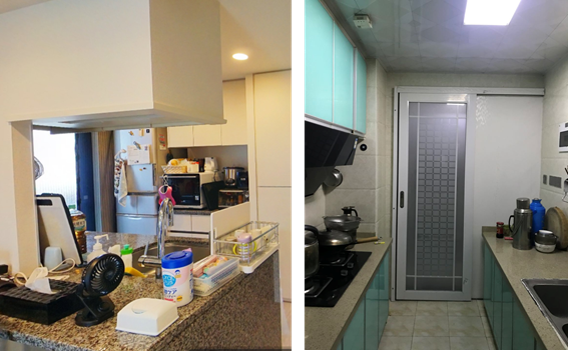
Japanese open kitchen where kitchen and dining are connected (left),
slightly narrow Chinese closed kitchen (right)
(Source: Consumer Database (Consumer Life Panorama))
Furthermore, differences can be seen in kitchen sinks. In Japan, it's common to have one sink and one faucet. In China, however, many households install two sinks and two faucets.
The reason is that there's a custom of using one sink for washing dishes and pots, and the other for washing vegetables. In China, people often soak vegetables thoroughly in water to wash off pesticide residues. Also, draining vegetables is a crucial step in Chinese cooking, making this design important.

Japanese kitchen sink (left) and Chinese kitchen sink (right)
(Source:Consumer Life Panorama)
Ventilation is a major challenge in Chinese kitchens, where issues like cooking oil, smoke, steam, and odors frequently arise. This article introduces the countermeasures implemented in Chinese kitchens.
(4) Is the refrigerator placed in the living room? And regarding the entranceway, the approach differs from Japan's.
In China, where many households prioritize an independent kitchen over maximizing space, it's common for refrigerators to be moved out of the kitchen and placed in the living-dining area.
While this may seem inconvenient at first glance, having the refrigerator in the space where family members gather most often offers the advantage of making it easy for everyone to access food and drinks according to their needs.
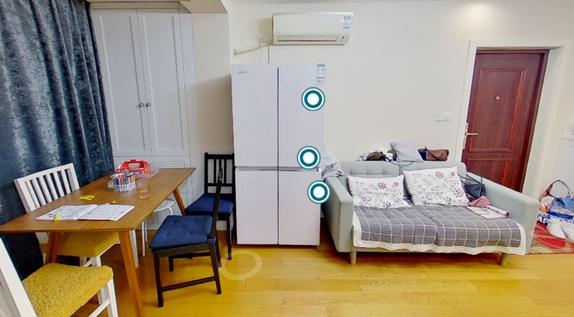
A refrigerator placed in Consumer database (Consumer Life Panorama)
Incidentally, differences can also be seen in the entrance hall, which serves as the home's gateway connecting to the living room.
In Japan, it's common for the entrance hall to lead through a hallway into the living/dining area, designed to protect privacy by preventing direct views into the living space from outside.
In contrast, older Chinese homes often feature structures where the entrance hall connects directly to the living room, or where the entrance space isn't clearly separated at all. This layout makes the interior easily visible from the entrance, reflecting a tendency to prioritize living flow and space efficiency over privacy.

Typical layout of an apartment building in Japan (left) and China (right)
(Source:Consumer database (Consumer Life Panorama))
In Japan, the longstanding custom of removing shoes when entering a home has led to many residences featuring a step at the entrance and standard shoe storage boxes. In China, however, it is common for people, including guests, to enter indoor spaces while still wearing shoes. Consequently, entrances often lack steps, and the entrance space itself has not traditionally been prioritized.
However, as urbanization advances and apartment living increases, the practice of removing shoes indoors is gradually spreading. This has brought shoe storage to the forefront as a new challenge. This article details how Chinese residents, now removing their shoes, are ingeniously solving their storage needs.
(5) Just because it's a Chinese household doesn't mean only Chinese appliances are used?
China is home to many major home appliance manufacturers, so one might expect that most appliances in Chinese households are made in China. However, this is not necessarily the case.
Particularly among high-income households, many families choose overseas brands such as German or Japanese appliances.

Refrigerator (Top) and Washing Machine (Bottom) Brand Nationality List
(Source: Consumer Life Panorama)
Of course, Chinese brands remain a strong presence. This stems from their ability to build unique strengths in specific areas.
① Quickly capturing shifts in consumers' lifestyles and reflecting them in products
For example, as Western-style cooking began to gain popularity, they launched IH cooktops that prioritize safety and ease of maintenance without relying on gas.
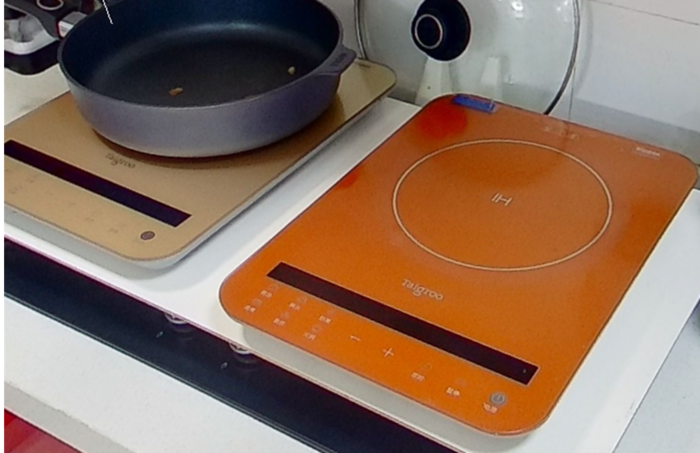
IH Cooktop (CN_28)
(Source: Consumer Life Panorama)
② Developing products tailored to China's unique lifestyle habits
In China, there is a custom of disinfecting children's clothing. To meet this need, Chinese brands have launched products like “compact washing machines specifically for children's clothes,” demonstrating a commitment to designing products that align closely with consumer demands.

CN_54 coffee machine (left) and compact washing machine for children's clothes (right)
(Source: Consumer Life Panorama database)
③ Actively introducing AI and IoT technologies while offering them at affordable prices
Smart speakers are not only being developed by BAT (Baidu, Alibaba, Tencent), but also by Xiaomi and Huawei. Xiaomi, in particular, has expanded its range of smart home appliances to form an ecosystem.

Smart speakers (left: CN_28, center: CN_30) and robot vacuum cleaners (right: CN_54)
(Source: Consumer Life Panorama)
China has its own unique home appliances, such as the “Onecup” coffee machine designed for children that can also make soy milk. For more details, please see the article below.
3. [Daily Life Edition] Since China has different housing environments, daily life within them naturally differs as well.
Urban residents in China have developed unique approaches to food, hygiene, and living environments. Their daily routines encompass diverse concerns—from beverage and dietary habits to dental care, indoor air quality, floor cleaning, and sleep patterns. Below, we explore various aspects of daily life alongside the realities of local residents, including hot water and sour food consumption, hygiene awareness, cleaning methods for different spaces, dental care, and sleep habits.
(1) Drink plain hot water instead of warm tea?
Hydration is essential for humans, but while Japanese restaurants typically serve water with ice (o-re), Chinese restaurants commonly provide hot tea. This reflects a desire to offer warm hospitality, coupled with China's strong emphasis on “hot water.”
According to traditional Chinese medicine's concept of yin-yang balance, drinking hot water has a “warming yang” effect, believed to warm the body and prevent illness. Furthermore, a government-led “drink boiled water” campaign spread nationwide in the 1950s, establishing it as a habit.
Consequently, electric kettles with heat-preserving functions have become almost essential in Chinese households, and many people carry stainless steel water bottles when going out. Thermoses from Japanese brands are particularly popular due to their high quality.
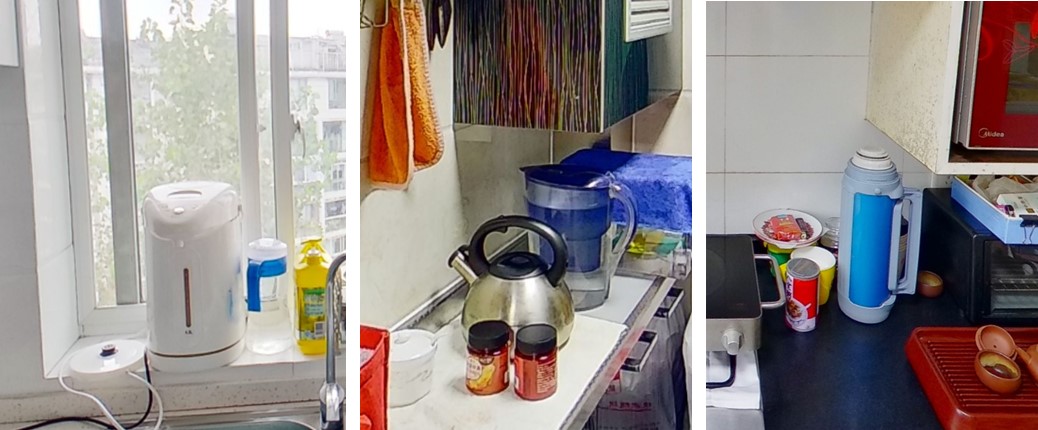
A Chinese house with a water heater (left), kettle (middle) and thermos (right).
* Source: Consumer Life Database ((Consumer Life Panorama))
For details on what Chinese consumers use to boil water and items they carry with them, please see this article.
(2) Chinese consumers embracing sour flavors
China has a long-established culture of using vinegar, so deeply ingrained in daily life that it is considered one of the seven essential necessities for living, alongside firewood, rice, oil, salt, soy sauce, and tea. Furthermore, China is a country that values the concept of health preservation. In traditional Chinese medicine, vinegar is believed to remove dampness from the body and help regulate its condition.
While rice vinegar is common in Japan, China features a diverse range including rice vinegar, white vinegar, aromatic vinegar, and aged vinegar, each used according to the dish. Consequently, Chinese home kitchens invariably stock several varieties of vinegar.
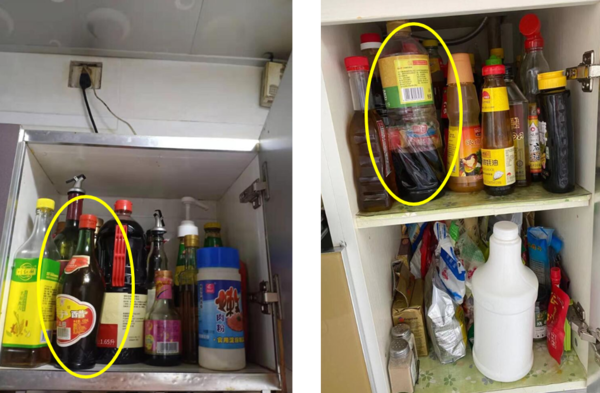
Vinegar always stored in Chinese kitchens (Left: CN_82, Right: CN_94)
(Source: Consumer Life Panorama)
China boasts four renowned vinegars: Jiangsu's “Zhenjiang Black Vinegar,” Shanxi's “Shanxi Aged Vinegar,” Sichuan's “Baoning Vinegar,” and Fujian's “Yongchun Aged Vinegar.” Vinegar has long been an integral part of the local diet. This article introduces the differences between each vinegar and how to use them.
(3) Differences in Hygiene Awareness Between China and Japan
It's well known worldwide that Japanese people have high hygiene standards, but in fact, hygiene awareness is gradually taking root in China today as well. Here, we introduce considerations for hygiene in clothing, food, and housing.
In households with children, adults risk exposing them to infection by coming into contact with various bacteria and viruses outside and bringing them home. Therefore, special care is taken with clothing. Some households have two washing machines—one for adults and one for children—or wash clothes separately. In some cases, clothes are even soaked in disinfectant before washing.
Among Shanghai's affluent, some families install two separate bathrooms—one for adults and one for children. Since people in China undress in the shower area, this practice helps prevent bacteria on clothing from affecting children's health.
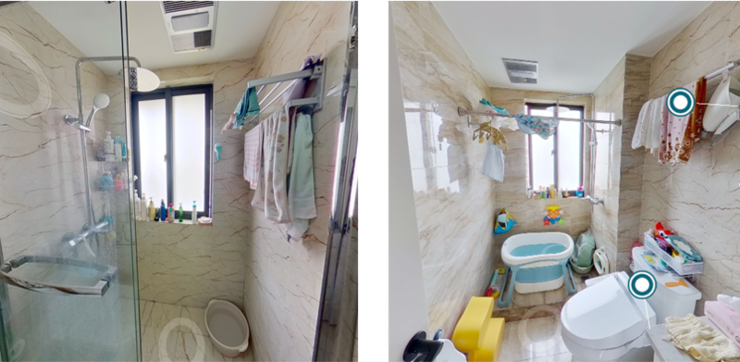
Adult bathroom (left) and children's bathroom (right)
(Source: Consumer Life Panorama)
In addition to hygiene awareness regarding food, clothing, and shelter, handwashing and disinfection are also emphasized as daily hygiene habits. In urban China, washing hands after returning home and before meals has become an established common practice.
This article introduces the specific actions Chinese consumers are actually taking for hygiene.
▶ Related Article:[China: World Residence Tour] Hygiene awareness of Chinese consumers
(4) Chinese Consumers Obsessed with Indoor Air Quality
Since air pollution like PM2.5 has drawn public attention, improving indoor air quality has also become increasingly important. There are four major factors affecting indoor air quality in Chinese homes:
① Cooking fumes from kitchens and dining areas
② Indoor PM2.5
③ Humidity
④ Formaldehyde emitted from wall paints and furniture
① and ③ can be improved through ventilation. However, in bathrooms where wet and dry areas cannot be separated, ventilation is difficult. Therefore, equipment integrating bathroom drying and heating, similar to Japanese designs, is increasingly being adopted.
② cannot be improved simply by opening windows, leading more households to install air purifiers.
④ currently has no effective countermeasure. The standard practice is to ventilate by opening windows for 2-3 months after interior finishing and move in only after levels have dropped to a safe threshold.
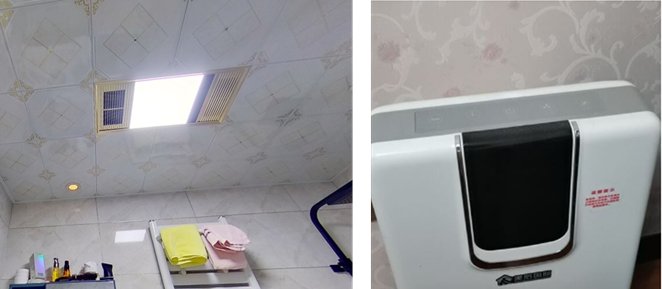
Chinese bathroom with ventilation system (CN_88) and air purifier installed in bedroom (CN_84)
Source: Consumer Life Panorama
▶ Related Article:[China: World Residence Tour] Commitment to Indoor Air Quality
(5) Dental Care Situation
In China, to promote dental health, September 20th has been designated as “National Love Your Teeth Day” every year since 1989, with efforts focused on spreading knowledge about dental care.
Regarding toothpaste, while foreign brands primarily emphasize “whitening” as their main selling point, domestic brands center their marketing around ‘herbal’ and “traditional Chinese medicine (TCM) ingredients.” Consumer trends suggest many prioritize whitening when choosing toothpaste.
While Japan's electric toothbrush penetration rate is said to be low among developed nations, China is still in the early stages of adoption, making its lower rate natural. However, among high-income households in health-conscious Shanghai, electric toothbrushes are already commonplace. Furthermore, considering hygiene, some households hang manual toothbrushes on walls and cover them to prevent dust accumulation.

Electric toothbrushes in Shanghai households (left: CN_113) and dust covers (right: CN_58)
(Source: Consumer Life Panorama)
Quantitative data on Chinese dental care behaviors and awareness is introduced in this article.
▶Related Article: [China: World Residence Tour] Dental Care of Chinese Consumers
(6) Cleaning methods specific to each space due to the use of different flooring materials
In Chinese homes, different flooring materials are used for each space. Flooring in living rooms and kitchens especially tends to differ from Japan. While hardwood flooring is common in Japan (mainly in apartments), Chinese households are divided between those who prefer marble or tile and those who favor hardwood. In China, where separate kitchens are preferred, marble or tile is often chosen because it makes cleaning splattered oil easier, a characteristic of Chinese cooking methods.
In China, floor cleaning isn't just about removing dust and debris. Alongside brooms and vacuum cleaners, mops and floor wipers are also used. While the order varies by household, the typical sequence is: first, remove dust and debris with a broom or vacuum cleaner; next, wipe the floor with a wet mop; and finally, finish with a dry mop. For Chinese people, sticky residue and grease stains cannot be removed solely by brooms or vacuum cleaners, making mopping an essential step.
Chinese households use multiple cleaning tools, but how do they store them? Alongside cleaning practices, we'll also explain storage methods.
(7) Sleep Patterns Among Chinese Consumers
Sleep accounts for about one-third of our lives, yet working adults in their thirties in China's major cities face challenges with sleep quality. One contributing factor is the bedroom environment. While many households once placed televisions in their bedrooms, the proliferation of smartphones has led to a decline in TVs. Instead, the habit of checking smartphones before bed has increased, and more homes now install charging outlets on both sides of the bed.

Schedule after 9 PM (left, CN_85, CN_55) and outlet near the bed (right, CN_111)
Source: Consumer Life Panorama
In Chinese homes, people are taking measures such as installing air purifiers and light-blocking curtains to improve sleep quality. For more details, please see this article.
4. Observing from a Marketing Perspective: Business Opportunities Revealed Through Chinese Daily Life
As we've seen, even among East Asian countries, Japan and China exhibit significant differences in how they utilize living spaces and their daily habits. Understanding each of these differences and their underlying reasons will be key to success when expanding into the Chinese market.
For instance, in China, where residential spaces tend to be compact despite the country's vast land area, there is demand for space-saving products with easy storage solutions. Furthermore, considering lifestyle habits distinct from Japan's, products like compact washing machines designed for parents who thoroughly disinfect items for their children have emerged.
Gaining detailed insights into Chinese consumers while based in Japan requires significant time and cost. We strongly encourage you to consider utilizing stock data such as the following.
What is Consumer Life Panorama?
This is a website-type database that has accumulated visual data on more than 1,000 sei-katsu-sha from 18 countries around the world. The database includes many 3D models of living environments and 2D data of items owned by each sei-katsu-sha, and is useful for understanding overseas sei-katsu-sha, which is difficult to grasp using only letters and numbers.
Using visual data such as those cited in this column,
Compare the differences in the attributes of overseas consumers
To get a realistic understanding of the actual usage of each category
To understand the overall lifestyle of target consumers
etc., can be utilized as a “no-go” home visit survey.
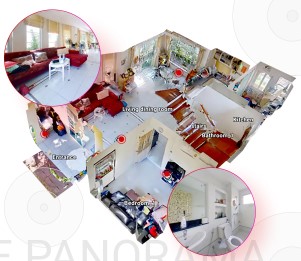
About Global Viewer
This service provides reports tailored to your issues using questionnaire data on various actual conditions and attitudes of sei-katsu-sha in 11 countries (Asia and US) stocked by INTAGE.
The service covers 400 items, including actual behavioral conditions and awareness, values, and information contact related to various product and service categories.

-

Editor profile
Chew Fong-Tat
Malaysian researcher who has lived in Japan for 14 years and has handled many surveys on ASEAN countries.
 Global Market Surfer
Global Market Surfer CLP
CLP

